Author: Steve Crum
With Drawing Pen in Hand…
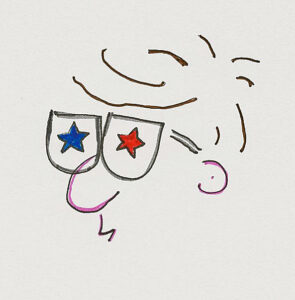 By Steve Crum
By Steve Crum
The first “Crummy Art” was “Sammy Shoe.” I started drawing these single panel cartoonies of a little guy with huge shoes during my elementary school years. They were distributed among childhood friends in my semi-rural Kansas City, Kansas neighborhood…around 1953-54, when I was 6 or 7. Incidentally, the Crum on Showbiz angle here surfaces soon enough. Trust me.
Influenced by comic books (Batman, Superman, Little Lulu, Herbie, Henry, and many others), I kept 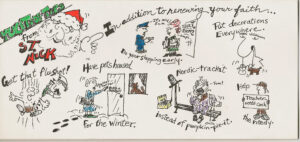 sketching. Yet I never took an art class in or out of school. Then came Wyandotte High School, and enrollment in journalism during my junior and senior years. On the Pantograph student newspaper, I was staff photographer, feature writer…and CARTOONIST! I later drew cartoons for my Emporia State University newspaper, “The Bulletin”; and for years created my own Crummy Christmas Cards. That led me to illustrating two textbooks, teaching posters, and a teacher’s tote bag at The University of Kansas.
sketching. Yet I never took an art class in or out of school. Then came Wyandotte High School, and enrollment in journalism during my junior and senior years. On the Pantograph student newspaper, I was staff photographer, feature writer…and CARTOONIST! I later drew cartoons for my Emporia State University newspaper, “The Bulletin”; and for years created my own Crummy Christmas Cards. That led me to illustrating two textbooks, teaching posters, and a teacher’s tote bag at The University of Kansas.
For a decade while teaching journalism in high school (35 years), I wrote a weekly entertainment column for “The Kansas City Kansan.” I would sometimes embellish my writing with cartoons. Samples follow. (You will probably need to enlarge your view.)
∞∞∞∞∞∞∞∞∞∞
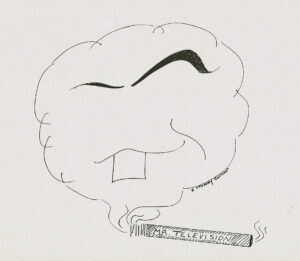 ON THE SAD OCCASION OF MILTON BERLE’S DEATH, I DREW HIM AS A WISP OF CIGAR SMOKE.
ON THE SAD OCCASION OF MILTON BERLE’S DEATH, I DREW HIM AS A WISP OF CIGAR SMOKE.
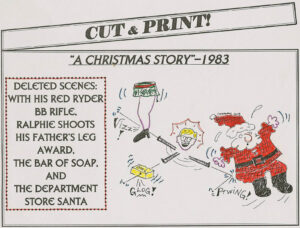 I PAID HOMAGE TO ONE OF THE BEST HOLIDAY MOVIES, A CHRISTMAS STORY, VIA THIS TWISTED RALPHIE IMAGE.
I PAID HOMAGE TO ONE OF THE BEST HOLIDAY MOVIES, A CHRISTMAS STORY, VIA THIS TWISTED RALPHIE IMAGE.
THIS IS THE ORIGINAL PRE-PUBLICATION PASTE-UP FOR MY TAKE ON E.T.—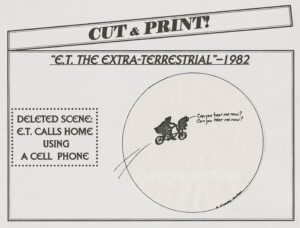 WHICH MADE FUN OF A THEN POPULAR COMMERCIAL.
WHICH MADE FUN OF A THEN POPULAR COMMERCIAL.
![]()
![]()
![]()
![]()
![]()
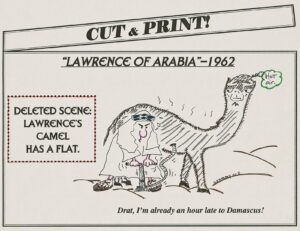 REFERENCING DAVID LEAN’S GREAT MOVIE IN CARTOONIE FORM…
REFERENCING DAVID LEAN’S GREAT MOVIE IN CARTOONIE FORM…
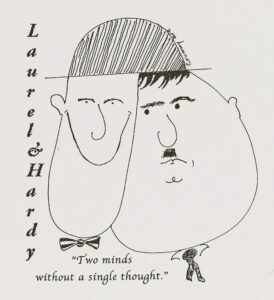
I HAVE BEEN A MEMBER OF THE SONS OF THE DESERT, THE INTERNATIONAL LAUREL AND HARDY FAN CLUB, FOR DECADES. MY TAKE OF THE BOYS…
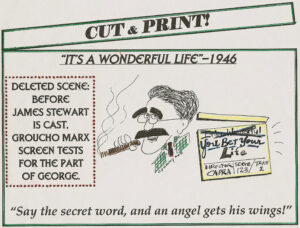
THE “TRUTH” ABOUT GROUCHO MARX AND JAMES STEWART!? (I REGRET THE MISTAKE OF NOT SHOWING GROUCHO IN A BOW TIE.)
∞∞∞∞∞
Thanks for perusing the Crum Gallery!
‘Belfast’ defines ‘instant classic’ by way of multiple Oscar-level performances, brilliant story telling
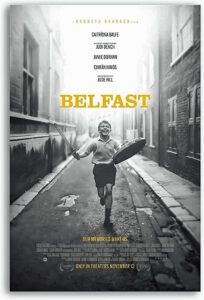 By Steve Crum
By Steve Crum
Mere minutes into the movie, you know something special, classically special, is unfolding. Its gentle grab of children cavorting in the street…the depiction of family life…the close proximity of the homes…are established.
Set in August 1969, Belfast is the story of an Irish family living in Northern Ireland whose life is told mainly through the youngest of the six, 9 year-old Buddy. Although touted as comedy-drama, the emphasis is predominantly serious drama. But identifying itself as “semi-biographical” is apt, since writer/director Kenneth Branagh based Belfast on his childhood. Branagh tells his story so vividly, so movingly.
During that time, Ireland was undergoing a tumultuous conflict within Belfast neighborhoods wherein Protestants and Catholics chose to stake their claims by segregating households block by block. It became standard that an entire section of houses was occupied by either Catholics or Protestants—never mixing within the blocks. Streets became territorial. It was akin to inner city street gang procedure. In fact, organized gangs did violently enforce the segregation. So it goes in Belfast.
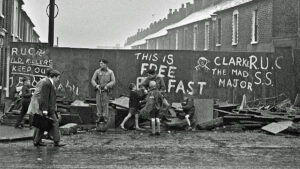 Amidst the peril of those times, we meet grade schooler Buddy and his family. (Their last names are not identified, presumably because they are closely based on Branagh’s family.) Their small house is one of lookalike dozens jammed next to each other and flanking the brick street. Their street is considered a Catholic neighborhood, and they are Protestant. They accept their neighbors, and vice versa. It is no surprise they are not popular with very nearby Protestant neighborhoods. When a Protestant-based gang decides to ramp up attacks (brick throwing, fire bombs), Buddy and his family are also targeted. As violence
Amidst the peril of those times, we meet grade schooler Buddy and his family. (Their last names are not identified, presumably because they are closely based on Branagh’s family.) Their small house is one of lookalike dozens jammed next to each other and flanking the brick street. Their street is considered a Catholic neighborhood, and they are Protestant. They accept their neighbors, and vice versa. It is no surprise they are not popular with very nearby Protestant neighborhoods. When a Protestant-based gang decides to ramp up attacks (brick throwing, fire bombs), Buddy and his family are also targeted. As violence 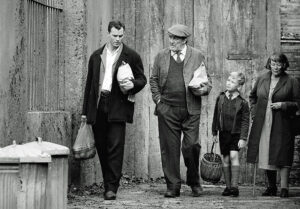 escalates, British soldiers are called in to keep the peace. That action is anything but calming, since the Brits and Irish are constantly at odds.
escalates, British soldiers are called in to keep the peace. That action is anything but calming, since the Brits and Irish are constantly at odds.
Definitely in harm’s way are Buddy (Jude Hill) and his family: “Ma,” (Caitríona Balfe), “Pa” (Jamie Dornan), older brother Will (Lewis McAskie), “Granny,” (Judi Dench), and “Pop,” the grandfather, an Oscar worthy performance by Ciarán Hinds. Really, all six are Academy Award level. Certainly they would qualify for any Best Ensemble Award.
Pa works overseas in England, and is absent for months at a time. That means Ma, Granny and Pop are left to raise the boys and keep the family safe. There are positives amidst the stress, however. Buddy and Will have fun with friends and teachers are school, and playing in the streets—whenever it is safe enough to 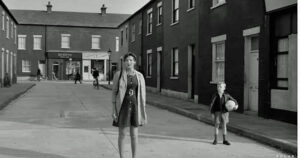 do so. They watch cartoons on the small black and white TV in the living room, and play with wooden swords. Buddy, in particular, has adventures with other children—not always sanctioned by Ma.
do so. They watch cartoons on the small black and white TV in the living room, and play with wooden swords. Buddy, in particular, has adventures with other children—not always sanctioned by Ma.
Buddy becomes very attached to Pop, and there is pause when Pop becomes ill. Pa wrestles with not being home to do his share in raising his boys, and being a good husband. When he does return home for a brief break, he is confronted by neighborhood bully/gang leader Billy Clanton (Colin Morgan), who pressures him to join the looting and burning “for the cause.” Pa rejects him, putting his family in more danger. Throughout all the tumult is a passion to love the family unit as well as one’s neighbors.
The look of the film, crediting both Branagh and cinematographer Haris Zambarloukos, is quite wonderful. The neighborhood becomes OUR neighborhood. So distinct it is, long past its 97 minute running time.
Special mention goes to Van Morrison, a Belfast native, who performs eight of his classic songs featured on the soundtrack…as well as a new one he wrote.
 The challenges felt by Buddy and his family do evolve to a finale laced with both hope and sadness. Granny’s closing remark evokes memories of Ma Joad in The Grapes of Wrath. Like then, it works. So well.
The challenges felt by Buddy and his family do evolve to a finale laced with both hope and sadness. Granny’s closing remark evokes memories of Ma Joad in The Grapes of Wrath. Like then, it works. So well.
——-
GRADE on an A-F Scale: A
Funny ‘Don’t Look Up’ blends satire, sci-fi–utilizing Hollywood’s finest
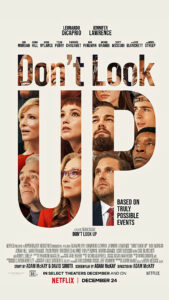 By Steve Crum
By Steve Crum
It is worth your while to look up (via Netflix) the satirically funny science fiction epic, Don’t Look Up. While you’re there, watch it closely for all the nuances and parallels to current events over the past five years—during the Trump presidency years particularly. You can’t miss them, since writer/director Adam McKay blatantly lays them out. That is the film’s strength AND weakness—explored later in this piece.
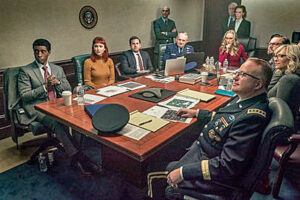 Don’t Look Up is a big production, not only in its 138-minute running time, but by its diamond studded cast of Oscar winners and nominees. Consider these Tiffany types: Leonardo DiCaprio, Jennifer Lawrence, Jonah Hill, Mark Rylance, Timothée Chalamet, Cate Blanchett, and Meryl Streep. It is also big in terms of the scope (the end of the world) and visual depictions thereof. (Not to give away too much, but the outer worldly sets and digitals are particularly spotlighted late in the movie.)
Don’t Look Up is a big production, not only in its 138-minute running time, but by its diamond studded cast of Oscar winners and nominees. Consider these Tiffany types: Leonardo DiCaprio, Jennifer Lawrence, Jonah Hill, Mark Rylance, Timothée Chalamet, Cate Blanchett, and Meryl Streep. It is also big in terms of the scope (the end of the world) and visual depictions thereof. (Not to give away too much, but the outer worldly sets and digitals are particularly spotlighted late in the movie.)
Plot-wise, the time is the present. Michigan State astronomers Dr. Randall Mindy (DiCaprio) and Kate Dibiasky (Lawrence) discover the potential end of earth via a large comet which will obliterate our planet in six
months. After informing NASA’s Planetary Defense Coordination Office honcho, Dr. Teddy Oglethorpe (Rob Morgan), the three trek to  The White House to present the doomsday findings to President Janie Orlean (Meryl Streep) and her son, Chief of Staff Jason Orlean (Jonah Hill).
The White House to present the doomsday findings to President Janie Orlean (Meryl Streep) and her son, Chief of Staff Jason Orlean (Jonah Hill).
After the Prez and her son reject the impending doom, Mindy and Dibiasky decide to alert the public through the media. Why not guest on a popular morning talk show hosted by Jack Bremmer (Tyler Perry) and Brie Evantee (Cate Blanchett)! Unfortunately, the talk show hosts spin the news as happy talk entertainment. When a high ranking official finally approves a plan to launch a missile to collide with the comet, offsetting its earth trajectory, billionaire Peter Isherwell (Mark Rylance) successfully cancels the plan. He has discovered a money making scheme to allow the comet to actually collide with earth.
Enough of the plot details. Just realize that more government execs, business bigwigs, and military brass enter into the wild scenario.  “Don’t Look Up” becomes a logo printed on baseball caps worn by President Orlean and her anti-destroy the comet followers. She and her compatriots have turned disaster into a fake news fantasy. A rallying cry is heard throughout the land—at least from the loud minority.
“Don’t Look Up” becomes a logo printed on baseball caps worn by President Orlean and her anti-destroy the comet followers. She and her compatriots have turned disaster into a fake news fantasy. A rallying cry is heard throughout the land—at least from the loud minority.
Although no real names are mentioned in this fantasy sci-fi tale, it is easy to translate the symbolism. President Janie Orlean is a more than a mere shade of Donald Trump; Hill’s Chief of Staff Jason Orlean could be a variety of lackeys, but comes across as Don Jr.; and on and on. The caps really tell the story.
Acting by all is stellar, particularly the zaniness of Jonah Hill and Mark Rylance. They mesh perfectly with the film’s absurdism.
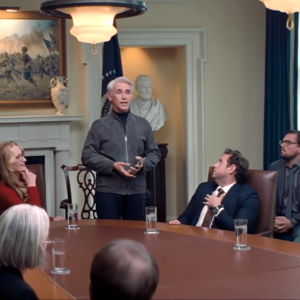 The big problem of Don’t Look Up is that which is being satirized is linked to a nightmarish satire itself. In other words, absorbing DLU becomes a bothersome dèjá vu unto itself. In most ways, it is too painfully true to be funny. It plays its wicked laughs to the proverbial choir of America’s political liberal and middle-of-the-roaders. That kick in the butt of recent history will surely not be appreciated by conservatives and far rightists. DLU reinterprets their red hat-ism.
The big problem of Don’t Look Up is that which is being satirized is linked to a nightmarish satire itself. In other words, absorbing DLU becomes a bothersome dèjá vu unto itself. In most ways, it is too painfully true to be funny. It plays its wicked laughs to the proverbial choir of America’s political liberal and middle-of-the-roaders. That kick in the butt of recent history will surely not be appreciated by conservatives and far rightists. DLU reinterprets their red hat-ism.
Don’t Look Up is no Dr. Strangelove in achieving lasting political satire brilliance, but it does mirror the times in which it was produced. We are talking some sad, pathetic and desperate years of fear and loathing in the good ol’ USA….that still exist with this writing.
∞∞∞∞∞
Incidentally, be sure to watch the end credits. More footage exists!
——-
GRADE on an A-F Scale: B
Spielberg’s ‘West Side Story’ dazzles with Bernstein, Sondheim score as well as terrific ensemble cast
 By Steve Crum
By Steve Crum
“It feels fresh,” said lyricist Stephen Sondheim about the new and in several ways improved West Side Story, shortly before he died on Nov. 26.
Sondheim is so correct.
It is undoubtedly a sacrilege to many fans saying that 1961’s musical film classic, West Side Story, is imperfect in any way. But casting actual ethnic actors and actual singers (Rachel Zegler and Ansel  Elgort) in the leads is smart and impactful. Sorry about that, Natalie Wood and Richard Beymer, whose voices were dubbed in the original. The fact that virtual unknowns Zegler and Elgort—notice their un-Hollywood-like names—can really sing AND act is double dose effective. They are terrific.
Elgort) in the leads is smart and impactful. Sorry about that, Natalie Wood and Richard Beymer, whose voices were dubbed in the original. The fact that virtual unknowns Zegler and Elgort—notice their un-Hollywood-like names—can really sing AND act is double dose effective. They are terrific.
Just as impressive are Ariana DeBose as Anita and David Alvarez’s Bernardo. Dynamite talents.
The “freshness” Sondheim references also includes songs being sung in different settings and slightly more naturalistic choreography—adapted by Justin Peck. Reportedly, Peck’s choreography is not a replication of Jerome Robbins’ original.
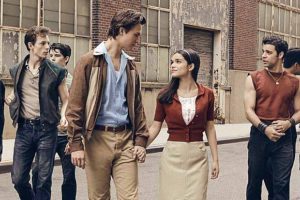 Before fleshing out the uniqueness of this Steven Spielberg-directed take, realize that the source material is still driven by Leonard Bernstein’s music, Sondheim’s lyrics, and Arthur Laurents’ book. (Screenwriter Ernest Lehman adapted the ’61 film.) Yet another adaptation is Bernstein’s original score, arranged by composer David Newman.
Before fleshing out the uniqueness of this Steven Spielberg-directed take, realize that the source material is still driven by Leonard Bernstein’s music, Sondheim’s lyrics, and Arthur Laurents’ book. (Screenwriter Ernest Lehman adapted the ’61 film.) Yet another adaptation is Bernstein’s original score, arranged by composer David Newman.
It all began with the 1957 Broadway show, which successfully transformed Shakespeare’s Romeo and Juliet into a story about two New York City inner city gangs in 1957. The Jets (whites) and the Sharks (Puerto Ricans) are enemies, and fiercely battle over their turfs. It is a simple premise given adrenalin  when Tony (Elgort) of the Jets and Maria (Zegler) of the Sharks fall in love with each other. It is a lethal no-no.
when Tony (Elgort) of the Jets and Maria (Zegler) of the Sharks fall in love with each other. It is a lethal no-no.
Spielberg and Kushner establish setting and time in the opening by showing ruins of tenement housing backing a sign declaring this is the future home of Lincoln Center. A particularly jarring camera shot is taken behind a large wrecking ball, as our view moves around it to see more distant rubble.
Cut to the Sharks as they invade Jet territory to do some paint vandalism, followed by a face-off with alerted Jets. The police soon arrive, led by Lt. Schrank (Corey Still), to stop the chaos. His speech to both gangs has  racist overtones (“spics”), clearly directed to the Puerto Ricans. Of course, police vs people of color is still a hot topic.
racist overtones (“spics”), clearly directed to the Puerto Ricans. Of course, police vs people of color is still a hot topic.
Overall, Kushner’s screenplay echos the Broadway script more than the 1961 movie. Rita Moreno, who won an Oscar for portraying Anita in the ’61 version, here plays Valentina, widow of Doc the candy store owner. (She runs it now.) Noticeable in this version is that many Puerto Ricans speak—now and then—in their native language, and without subtitles.
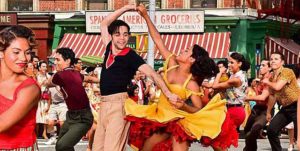 Two changes are really applause worthy, the first being that instead of performing the rousing “America” on a rooftop, it takes to the wide open streets of the Sharks’ neighborhood. The number is even more of a standout. Secondly, I loved the color and cleverness of setting the lively “I Feel Pretty” number inside Gimbels Department Store. (Maria and friends work there nights as cleaners.) Even Windex is part of the choreography!
Two changes are really applause worthy, the first being that instead of performing the rousing “America” on a rooftop, it takes to the wide open streets of the Sharks’ neighborhood. The number is even more of a standout. Secondly, I loved the color and cleverness of setting the lively “I Feel Pretty” number inside Gimbels Department Store. (Maria and friends work there nights as cleaners.) Even Windex is part of the choreography!
Be aware that this is 2021, and the rumbles are more graphically violent.
But at its heart, West Side Story is a tragic love story. I still teared up at its poignant conclusion.
Spielberg’s reimagining is a must-see and a will-love.
——-
GRADE on an A-F Scale: A
Aaron Sorkin showcases endearment for Lucy & Desi via insightful ‘Being the Ricardos’
 By Steve Crum
By Steve Crum
Lucille Ball and Desi Arnaz were great. Nicole Kidman and Javier Bardem are great portraying them. There. I have channeled what Lucy & Ricky fans want to know first about Aaron Sorkin’s wonderfully conceived Being the Ricardos.
The bittersweet film, written and directed by Sorkin, stands as not only a behind-the-scenes look at Mr. and Mrs. Arnaz, including how they met, but a testament to the gem among gems of early 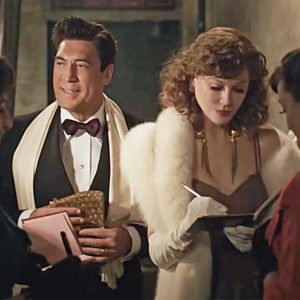 television. I Love Lucy (1951-57) influenced the technology and format of sitcoms, particularly, to this day. In that sense, Being the Ricardos is more historical than hysterical. The laughs are limited with an emphasis on drama.
television. I Love Lucy (1951-57) influenced the technology and format of sitcoms, particularly, to this day. In that sense, Being the Ricardos is more historical than hysterical. The laughs are limited with an emphasis on drama.
Overall, Sorkin’s crisp and savvy dialogue dominates. But how did he successfully pull off this biographical ruse?
Aaron Sorkin’s screenplay and direction accomplishes the switch several ways. Before going further, realize that the audience for Being the Ricardos has to be I Love Lucy fans. (Compared to today’s popular TV shows that are considered a hit with 15 million viewers, I Love Lucy consistently played to 60 million per episode!) The viewer demographic, therefore, is middle-aged to Baby Boomer. That premise is totally reliant on the audience having seen at least the classic I Love Lucy episodes. That includes the Lucy stomping grapes, the Lucy pregnant 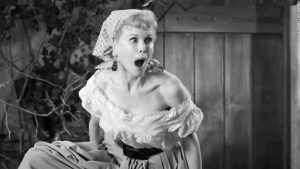 with Little Ricky, and the Lucy trying to reunite a quarreling Fred and Ethel.
with Little Ricky, and the Lucy trying to reunite a quarreling Fred and Ethel.
The next given, which is pretty brilliant, involves not showing too much of, say, the hilarious winery/grape stomping sequence. Just set it up by duplicating the Italian winery set, and placing Kidman in matching Lucy costume. Then have her repeat the original TV dialogue as she steps into the grape vat. She does a pratfall, but that is all we see. It’s all we need to see because we have seen the original so many times. Our minds fill in the slapstick gaps.
There is no need for Nicole Kidman to fully duplicate the classic physical shtick, which is a plus since there is no way anyone could do so. She gives us enough to suggest the hilarity that will follow.
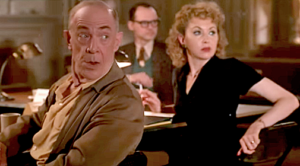 Also, Kidman’s makeup, body language, and voice are more than enough to suggest Lucille Ball. It is uncanny.
Also, Kidman’s makeup, body language, and voice are more than enough to suggest Lucille Ball. It is uncanny.
The same elements of suggestion are carried out by Bardem’s Ricky/Desi, Nina Arianda’s Ethel/Vivian, and J. K. Simmons’ Fred/William. Their channeling of the actual characters and actors quickly becomes our channeling of their transformations. Again a stretch, but it works.
Really, not even 1/4 of Being the Ricardos showcases the actual filmed episodes of I Love Lucy. That means Kidman and Co. are mainly realized as Lucille Ball, Desi Arnaz, Vivian Vance and William Frawley. Totally 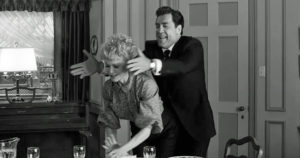 believable they are. Bardem is definitely not a Desi Arnaz double, but we accept him as Desi. Acting, ladies and gentlemen!
believable they are. Bardem is definitely not a Desi Arnaz double, but we accept him as Desi. Acting, ladies and gentlemen!
In that vein, an award for Best Ensemble should include Tony Hale as Producer Jess Oppenheimer, Alia Shawkat’s co-writer Madelyn Pugh, and Jake Lacy’s co-writer Bob Carroll Jr. Their interplay during the table readings is delicious—Sorkin at his best.
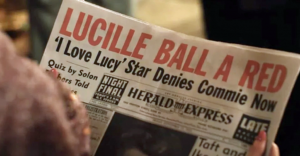 Appropriately covered are Desi’s philandering and Lucy’s distrust of him; William Frawley’s incessant digs at Vivian Vance; and Lucy’s being labeled a Communist.
Appropriately covered are Desi’s philandering and Lucy’s distrust of him; William Frawley’s incessant digs at Vivian Vance; and Lucy’s being labeled a Communist.
As for scenes of Ricky belting out Babalu and Cuban Pete (Desi’s signature songs), it is Javier Bardem’s own voice, accompanied by his own conga playing.
Being the Ricardos amounts to a very enlightening and entertaining dramedy encased in a 20th Century time capsule.
——-
GRADE on an A-F Scale: A-
